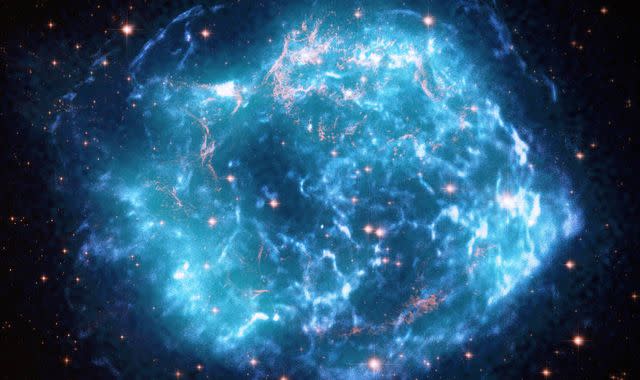Astronomers have mapped the remains of a dead star - with surprising results

The remains of an exploded star have been examined in detail for the first time.
Using telescopes attached to an observatory launched into space last year, astronomers have mapped and measured polarised X-rays of the remains of dead supernova Cassiopeia A.
NASA and the Italian Space Agency collaborated on the Imaging X-ray Polarimetry Explorer (IXPE), which was fired into orbit last December.
It has three telescopes, designed to measure scans of black holes, stars, and other interstellar phenomenons.
Cassiopeia A was chosen because it generated some of the fastest shock waves ever measured in the Milky Way when it collapsed, NASA said.
The star has previously been studied using radio telescopes and NASA's older Chandra X-ray Observatory, and a new composite image released by NASA was made using data from those plus IXPE.
Astronomers were surprised by IXPE's findings, specifically regarding the behaviour of the star's magnetic fields.
What are magnetic fields?
To us at home, they keep magnets attached to the fridge.
The fields push and pull on moving charged particles like protons and electrons - in the case of an exploded star, these forces are much greater, with the magnetic fields capable of boosting these particles to almost light speed.
With Cassiopeia A, the magnetic fields were so strong that the particles were trapped, forced to spiral around in the wake of its shock waves and give off an intense polarised light called "synchrotron radiation".
What do we mean by polarised light?
Think of light as a wave, vibrating up and down at various angles.
When light is polarised, those waves vibrate only at one angle.
There's another good homely example to help explain this one: your sunglasses.
All forms of light can polarised, and in the case of sunglasses, they help our eyes manage the glare of sunlight.
With IXPE, it has detectors which can track incoming X-ray light, and from there, scientists can get a better idea of what's happening inside Cassiopeia A.
And what did NASA's scientists find?
So far as the astronomers are concerned, it looks chaotic in there.
Previous studies using radio telescopes showed that synchrotron radiation was being produced across pretty much the entire corpse of the star.
And scientists assumed that X-ray polarisation would be produced by magnetic fields that are perpendicular to the magnetic fields previously observed by radio telescopes.
But IXPE produced unexpected results, with the magnetic fields in the X-rays aligned instead in radial directions, sometimes very close to the shock waves, and far less polarised light than had been previously found.
NASA says it suggests the X-rays were taken in extremely turbulent regions of the star's remains, with a mix of magnetic fields pushing and pulling in all sorts of directions.
"These IXPE results were not what we expected, but as scientists we love being surprised," said Dr Jacco Vink, a University of Amsterdam researcher and lead author of the paper describing IXPE's findings.
"The fact that a smaller percentage of the X-ray light is polarised is a very interesting - and previously undetected - property of Cas A."
Co-author Dr Riccardo Ferrazzoli said the star's remains had proved to be an "astrophysical laboratory" for astronomers to test new equipment and techniques.
"We are just at the beginning of this detective story, but so far the IXPE data are providing new leads for us to track down," he added.
For more on science and technology, explore the future with Sky News at Big Ideas Live 2022.
Find out more and book tickets here

 Yahoo News
Yahoo News 
